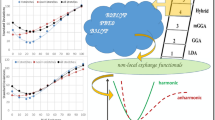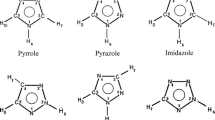Abstract
Lignin is the most abundant aromatic plant polymer on earth. Useful information on its structure and interactions is gained by vibrational spectroscopy and relies on the quality of band assignments. B3LYP predictions were recently shown to support band assignments. Further progress calls for a comprehensive study of the quality of available theoretical methods in relation to the task of predicting lignin vibrational properties. The present study examined more than 50 functionals for prediction of IR vibrations of an appropriate lignin model. Based on a basis set incompleteness study, the pc-2 basis set was used. B98, X3LYP and B97-1 were the overall best-performing functionals, and “fingerprint” band positions were predicted by single-factor scaling of harmonic frequencies to an average error of ±3 cm−1 by optimized scaling factors of 1.017, 1.021 and 1.016, respectively. Their performance using instead explicit anharmonic correction was slightly worse giving an error of ca. ±5 cm−1. The X3LYP and B97-1 functionals offer also good description of hydrogen bonding. Error compensation from, e.g., insufficient treatment of solvation is likely to affect these results, and thus at this stage no single functional stands out. These results provide a needed basis for further theoretical developments in relation to vibrational assignments of Infrared and Raman spectra of lignin.




Similar content being viewed by others
References
Azadi P, Inderwildi OR, Farnood R, King DA (2013) Liquid fuels, hydrogen and chemicals from lignin: a critical review. Renew Sustain Energy Rev 21:506–523
Eudes A, Liang Y, Mitra P, Loque D (2014) Lignin bioengineering. Curr Opin Biotechnol 26:189–198
Kang SM, Li XL, Fan J, Chang J (2013) Hydrothermal conversion of lignin: a review. Renew Sustain Energy Rev 27:546–558
Ragauskas AJ, Beckham GT, Biddy MJ, Chandra R, Chen F et al (2014) Lignin valorization: improving lignin processing in the biorefinery. Science 344:709
Bonawitz ND, Chapple C (2010) The genetics of lignin biosynthesis: connecting genotype to phenotype. In: Campbell A, Lichten M, Schupbach G (eds) Annual review of genetics, vol 44. Annual Reviews, Palo Alto, pp 337–363
Vanholme R, Demedts B, Morreel K, Ralph J, Boerjan W (2010) Lignin biosynthesis and structure. Plant Physiol 153:895–905
Zhao Q, Dixon RA (2011) Transcriptional networks for lignin biosynthesis: more complex than we thought? Trends Plant Sci 16:227–233
Garrigues S, de la Guardia M (2013) Non-invasive analysis of solid samples. Trac Trends Anal Chem 43:161–173
Lupoi JS, Singh S, Simmons BA, Henry RJ (2014) Assessment of lignocellulosic biomass using analytical spectroscopy: an evolution to high-throughput techniques. Bioenerg Res 7:1–23
Xu F, Yu JM, Tesso T, Dowell F, Wang DH (2013) Qualitative and quantitative analysis of lignocellulosic biomass using infrared techniques: a mini-review. Appl Energy 104:801–809
Agarwal UP (2006) Raman imaging to investigate ultrastructure and composition of plant cell walls: distribution of lignin and cellulose in black spruce wood (Picea mariana). Planta 224:1141–1153
Fackler K, Thygesen LG (2013) Microspectroscopy as applied to the study of wood molecular structure. Wood Sci Technol 47:203–222
Gierlinger N, Keplinger T, Harrington M (2012) Imaging of plant cell walls by confocal Raman microscopy. Nat Protoc 7:1694–1708
Gierlinger N, Schwanninger M (2007) The potential of Raman microscopy and Raman imaging in plant research. Spectrosc Int J 21:69–89
Halttunen M, Vyorykka J, Hortling B, Tamminen T, Batchelder D et al (2001) Study of residual lignin in pulp by UV resonance Raman spectroscopy. Holzforschung 55:631–638
Barsberg S, Matousek P, Towrie M, Jorgensen H, Felby C (2006) Lignin radicals in the plant cell wall probed by Kerr-gated resonance Raman spectroscopy. Biophys J 90:2978–2986
Barsberg S, Matousek P, Towrie M (2005) Structural analysis of lignin by resonance Raman spectroscopy. Macromol Biosci 5:743–752
Faix O (1991) Classification of lignins from different botanical origins by FT-IR spectroscopy. Holzforschung 45:21–27
Faix O, Beinhoff O (1988) FTIR spectra of milled wood lignins and lignin polymer models (DHPS) with enhanced resolution obtained by deconvolution. J Wood Chem Technol 8:505–522
Agarwal UP, McSweeny JD, Ralph SA (2011) FT-Raman investigation of milled-wood lignins: softwood, hardwood, and chemically modified black spruce lignins. J Wood Chem Technol 31:324–344
Agarwal UP, Ralph SA (1997) FT-Raman spectroscopy of wood: identifying contributions of lignin and carbohydrate polymers in the spectrum of black spruce (Picea mariana). Appl Spectrosc 51:1648–1655
Gilarranz MA, Rodriguez F, Oliet M, Garcia J, Alonso V (2001) Phenolic OH group estimation by FTIR and UV spectroscopy. Application to organosolv lignins. J Wood Chem Technol 21:387–395
Huang Y, Wang LS, Chao YS, Nawawi DS, Akiyama T et al (2012) Analysis of lignin aromatic structure in wood based on the IR spectrum. J Wood Chem Technol 32:294–303
Karmanov AP, Derkacheva OY (2013) Application of fourier transform infrared spectroscopy for the study of lignins of herbaceous plants. Rus J Bioorg Chem 39:677–685
Saariaho AM, Jaaskelainen AS, Nuopponen M, Vuorinen T (2003) Ultra violet resonance Raman spectroscopy in lignin analysis: determination of characteristic vibrations of p-hydroxyphenyl, guaiacyl, and syringyl lignin structures. Appl Spectrosc 57:58–66
Sun L, Varanasi P, Yang F, Loque D, Simmons BA et al (2012) Rapid determination of syringyl: guaiacyl ratios using FT-Raman spectroscopy. Biotechnol Bioeng 109:647–656
Janesko BG (2014) Acid-catalyzed hydrolysis of lignin beta-O-4 linkages in ionic liquid solvents: a computational mechanistic study. Phys Chem Chem Phys 16:5423–5433
Kim S, Chmely SC, Nimos MR, Bomble YJ, Foust TD et al (2011) Computational study of bond dissociation enthalpies for a large range of native and modified lignins. J Phys Chem Lett 2:2846–2852
Parthasarathi R, Romero RA, Redondo A, Gnanakaran S (2011) Theoretical study of the remarkably diverse linkages in lignin. J Phys Chem Lett 2:2660–2666
Sangha AK, Davison BH, Standaert RF, Davis MF, Smith JC et al (2014) Chemical factors that control lignin polymerization. J Phys Chem B 118:164–170
Sangha AK, Parks JM, Standaert RF, Ziebell A, Davis M et al (2012) Radical coupling reactions in lignin synthesis: a density functional theory study. J Phys Chem B 116:4760–4768
Elder T, Beste A (2014) Density functional theory study of the concerted pyrolysis mechanism for lignin models. Energy Fuels 28:5229–5235
Larsen KL, Barsberg S (2010) Theoretical and Raman spectroscopic studies of phenolic lignin model monomers. J Phys Chem B 114:8009–8021
Laury ML, Carlson MJ, Wilson AK (2012) Vibrational frequency scale factors for density functional theory and the polarization consistent basis sets. J Comput Chem 33:2380–2387
Scott AP, Radom L (1996) Harmonic vibrational frequencies: an evaluation of Hartree-Fock, Moller-Plesset, quadratic configuration interaction, density functional theory, and semiempirical scale factors. J Phys Chem 100:16502–16513
Sinha P, Boesch SE, Gu CM, Wheeler RA, Wilson AK (2004) Harmonic vibrational frequencies: scaling factors for HF, B3LYP, and MP2 methods in combination with correlation consistent basis sets. J Phys Chem A 108:9213–9217
Zhao Y, Truhlar DG (2008) The M06 suite of density functionals for main group thermochemistry, thermochemical kinetics, noncovalent interactions, excited states, and transition elements: two new functionals and systematic testing of four M06-class functionals and 12 other functionals. Theor Chem Acc 120:215–241
Zvereva EE, Shagidullin AR, Katsyuba SA (2011) Ab initio and DFT predictions of infrared intensities and Raman activities. J Phys Chem A 115:63–69
Jimenez-Hoyos CA, Janesko BG, Scuseria GE (2008) Evaluation of range-separated hybrid density functionals for the prediction of vibrational frequencies, infrared intensities, and Raman activities. Phys Chem Chem Phys 10:6621–6629
Jensen F (2001) Polarization consistent basis sets: principles. J Chem Phys 115:9113–9125
Jensen F (2002) Polarization consistent basis sets. II. Estimating the Kohn-Sham basis set limit. J Chem Phys 116:7372–7379
Jensen F (2002) Polarization consistent basis sets. III. The importance of diffuse functions. J Chem Phys 117:9234–9240
Jensen F (2003) Polarization consistent basis sets. IV. The basis set convergence of equilibrium geometries, harmonic vibrational frequencies, and intensities. J Chem Phys 118:2459–2463
Zhao Y, Schultz NE, Truhlar DG (2006) Design of density functionals by combining the method of constraint satisfaction with parametrization for thermochemistry, thermochemical kinetics, and noncovalent interactions. J Chem Theory Comput 2:364–382
Hohenstein EG, Chill ST, Sherrill CD (2008) Assessment of the performance of the M05-2X and M06-2X exchange-correlation functionals for noncovalent interactions in biomolecules. J Chem Theory Comput 4:1996–2000
Cappelli C, Monti S, Scalmani G, Barone V (2010) On the calculation of vibrational frequencies for molecules in solution beyond the harmonic approximation. J Chem Theory Comput 6:1660–1669
Barone V, Baiardi A, Biczysko M, Bloino J, Cappelli C et al (2012) Implementation and validation of a multi-purpose virtual spectrometer for large systems in complex environments. Phys Chem Chem Phys 14:12404–12422
Barone V, Biczysko M, Bloino J (2014) Fully anharmonic IR and Raman spectra of medium-size molecular systems: accuracy and interpretation. Phys Chem Chem Phys 16:1759–1787
Barone V, Biczysko M, Bloino J, Puzzarini C (2013) Characterization of the elusive conformers of glycine from state-of-the-art structural, thermodynamic, and spectroscopic computations: theory complements experiment. J Chem Theory Comput 9:1533–1547
Xu X, Goddard WA (2004) The X3LYP extended density functional for accurate descriptions of nonbond interactions, spin states, and thermochemical properties. Proc Natl Acad Sci USA 101:2673–2677
Rao L, Ke HW, Fu G, Xu X, Yan YJ (2009) Performance of several density functional theory methods on describing hydrogen-bond interactions. J Chem Theory Comput 5:86–96
Author information
Authors and Affiliations
Corresponding author
Rights and permissions
About this article
Cite this article
Barsberg, S. Identification of the best DFT functionals for a reliable prediction of lignin vibrational properties. Theor Chem Acc 134, 33 (2015). https://doi.org/10.1007/s00214-015-1638-2
Received:
Accepted:
Published:
DOI: https://doi.org/10.1007/s00214-015-1638-2




